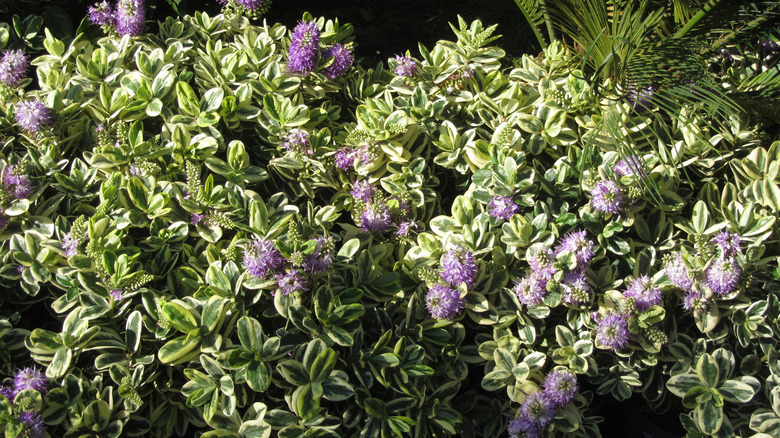The Best Time Of Year To Prune Hebe Shrubs To Ensure Beautiful Blooms
Hebe shrubs are the unsung heroes of the garden, keeping the place lit with life all year round. Picture these compact, bushy shrubs lining your borders, their green (sometimes variegated or pink) foliage throwing texture into the mix. And don't get us started on their flower spikes — they are like little sips of heaven for pollinators. We're talking about a dazzling range from red, blue, and lavender, to white that not only catches your eye but also beckons hummingbirds, bumblebees, and butterflies. Keeping these beautiful blooms coming involves pruning. But don't be mistaken, for this isn't just chopping bits off. It's also about the precise moment when you set the stage for the forthcoming floral spectacle. And the best time to prune a Hebe shrubs? When flowers fade, typically somewhere between late winter and early spring, that's your window.
Now, why is correct timing such a big deal for pruning hebe shrubs? Do it too early or too late, and bam, you've unintentionally given the boot to the next round of flowering buds. Get it right, and you can expect bigger, bolder blooms since you are helping your shrubs channel their energy on fewer buds. In addition, think of pruning as a tidy-up, where clearing the dead flowers and damaged or dead branches keeps your hebes looking sharp. Plus, it's a critical part of taming overgrown shrubs, maintaining that compacted, rounded shape we've become accustomed to and keeping your yard looking snazzy.
When to prune hebe shrubs
Late winter or early spring is your window of opportunity to prune hebes, after the flowers have taken their final bow but before new growth kicks in. This typical sweet spot lets your shrubs recover and harness the full energy of the growing season to bolster their blooms. Prune too early, and you might cut off this year's blooms prematurely. Wait too long, and those buds destined for the next season's spectacle will be lost since hebes bud up just as the last flower waves goodbye.
However, hebes, being one of the shrubs with purple flowers that will bring color to your yard, aren't cut from the same cloth. For varieties that strut their stuff in summer (think Veronica 'Great Orme'), immediately after their flowering period ends in late summer is the ideal pruning time to keep their blooming rhythm uninterrupted.
As for the early birds that bloom in spring, resist the temptation to prune in late winter; otherwise, you risk removing the very buds that will unfurl the spring flowers. Patience is your friend here; wait a couple of weeks after the bloom before making a move. That gives your shrubs enough time to recover before they start producing flower buds in late summer or early fall. Let's not forget hebe shrubs that suffer damage from harsh winters. A pruning session in later winter and early spring gives these green companions a fresh start. Speak of turning damage into dazzling when the growth starts.
How to prune your hebe shrubs like a pro
Pruning hebes begins with gathering the essentials. Bypass pruning shears like the Fiskars ⅝ inch Cut Capacity Bypass Pruning Sheers, going for about $14 at Home Depot, are perfect for smaller branches. For beefier stems, a pair of loppers will suffice. Don't forget to wear well-padded gloves to reduce strain and safeguard against potential cuts. Also, your tools could be sneaky carriers of plant pathogens. Quick dabs or swipes with rubbing alcohol or diluted chlorine bleach during pruning is a smart move.
Now, onto the fun part. Spot and snip off those spent flower spikes on your hebe shrub. Then, play detective and hunt down dead, damaged, or diseased parts and get rid of them. Once you've decluttered, it's time to finesse the shape of your hebe by giving it just a light trim. Chopping off more than a third of the hebe's volume in one go is one of the mistakes to avoid when pruning your plants. Your green companions need leaves to photosynthesize and stay perky.
Remember, going too hard on pruning hebe shrubs (read, cutting back into woody stems) might lead to a growth timeout. For shrubs that are getting a bit too leggy, opt for several staggered trims, rather than going all in with one drastic cut. Post-pruning, pamper your shrubs with general-purpose or high-potassium fertilizer. Adding a layer of mulch around the base after watering seals the deal, but keep the material off the bark to prevent rot.


